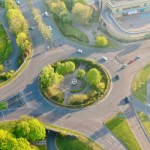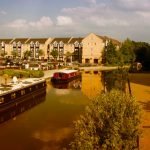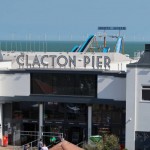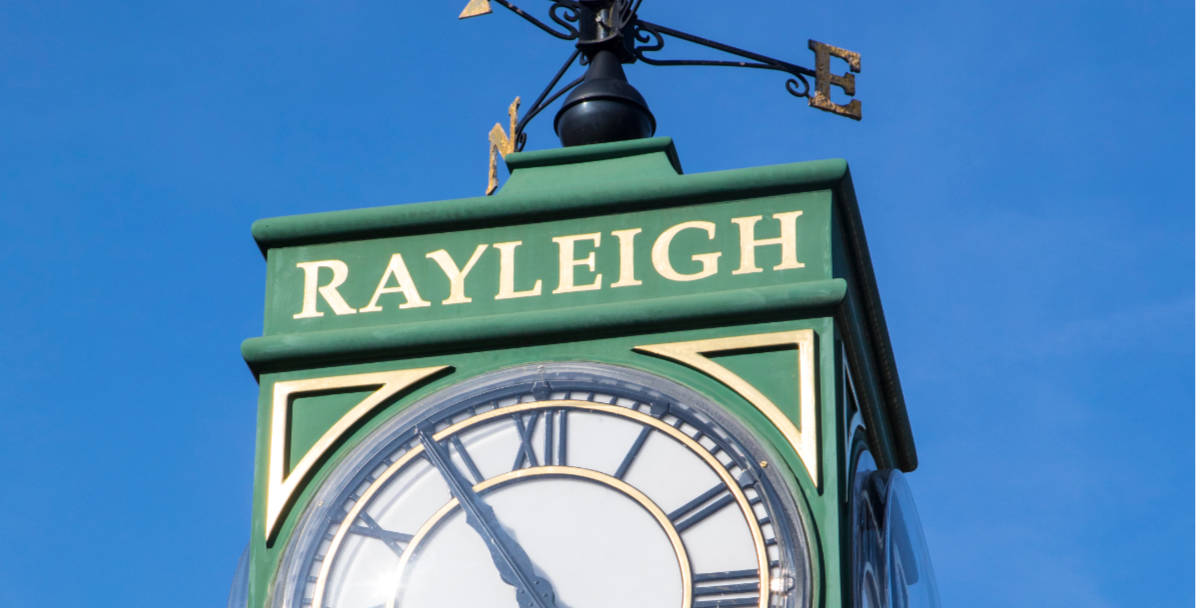
The Five Minute Guide to Rayleigh
Consider Rayleigh as a potential staycation destination for this season’s next holiday.
Some 32 miles to the east of London, you will find the Essex town of Rayleigh. With only 32,000 people living there, this quaint little market town is a somewhat quiet, reflective town, which is neither on the coast nor part of the city.
It is thought that this sleepy market town has been occupied since prehistoric times. The name really comes from the old English words for a clearing and a female deer. Perhaps the town was built where the female deer nested with their calves. There is very few little deer in Rayleigh now, although you may meet a few here and there.
However, Rayleigh came to be, it is now a popular commuter town for those working in London who don’t necessarily want to pay London rent prices. Let’s review whether Rayleigh makes a good place to visit for a country break, or whether it is best left alone.
Let’s start with the history of the town and later cover the attractions you might find there.
Early History of Rayleigh
Rayleigh has been occupied since at least Roman times. Tiles have been found in the area surrounding Rayleigh church which seems to date from the Roman period. This means that the town was likely home to a villa or some other Roman building. We don’t know how big the town was at the time, only that the Romans were here.
In the early ’00s, archaeologists found a Saxon cemetery near the site of the old school in Rayleigh town. They found evidence of 144 cremation burials, suggesting that Raleigh was Inhabited heavily after the Romans left. The next recorded evidence we have of a settlement at Rayleigh is within the Domesday Survey, which was conducted in 1186. However, the Norman period began in 1066, and if the burials were dated to the Saxon period, then they died before then.
Doomsday Rayleigh
The Domesday Survey was conducted in 1086, 20 years after the Normans successfully invaded Britain. It was conducted by king William the Conqueror, who wanted to see what he had won – and who he should be taxing. At the time of the survey, Rayleigh was in the 100 of Rochford and was one of the largest 20% of settlements recorded. It was comprised of some 35 households… which makes it more than the small village some might have believed it to be.
Rayleigh had two different owners in 1086. They are recorded as both being the same person. The lands belonged to Swein of Essex, who seems to have been an extraordinarily rich man indeed. Swein owned 10 acres of meadows and 14 plough teams to work them. He owned woodland that contained 40 pigs and houses enough to contain 19 smallholders, 6 villagers, and 2 slaves. He had more than 20 cattle and over 80 sheep. The land was worth £10, a princely sum.
During Norman times the town was so significant that there was even a castle here. This was a motte and bailey castle and is still visible as a mound that overlooks the town centre. If Rayleigh had continued to grow with the same popularity as it had during Norman times, it would be a city by now. The castle is still visible to this day although only in raised grounds and layout.
Mediaeval Rayleigh
During mediaeval times, Rayleigh continued to grow in importance. In the 14th century, Rayleigh had its own courthouse. This was an issue among the local people who didn’t really want their own courthouse. 20 people were arrested after riots among those who did not want the courthouse in town. In the 13th century, King Henry the third would hunt here and the forests, which would likely still have contained swine at the time.
In 1350 the regal room of the Rayleigh Town Museum was built. It is thought to be the oldest structure in town. By the year 1394, the town had overgrown the castle, which had fallen into disrepair. The king at the time gave his permission for the people to use the stone of the castle to build more properties of their own. As a result, many of the town’s buildings contained stonework from the original castle. Instead of rebuilding the castle, King Richard the second decided to use it for pastureland. Arguably, it was this decision that would have lowered the status of the town over time.
Put To Good Use
The castle may have disappeared, however, the locals made good use of the surplus store as some of it was used to build the bell tower of the Holy Trinity parish church. This is a wonder of architecture having some early Saxon features but also norman aspects and of course a rather impressive Tudor porch. Well worth a visit if you like old buildings or for that all-important Instagram selfie!
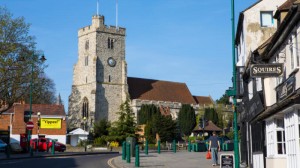
Image: chrisdorney/Shutterstock.com
During the next couple of 100 years, Rayleigh turned into a town that was more grassland than it was buildings. Its former Importance was largely forgotten. Instead, it was used as a breeding ground for royal deer. Stocks for Greenwich Park would be replenished from the fields and meadows of the area around Rayleigh.
As the years passed, the town grew smaller and smaller. With the royal interest in the area ending with Edward III, the town was left to its own device. It was neither a royal destination nor a large market town, although it was the biggest among a series of villages, allowing it to hold weekly markets and yearly fairs.
In 1555, two protestant martyrs from the town were burned at the stake for refusing to denounce their beliefs. A memorial to them was later erected in 1908 at the top of Crown Hill.
We will go through the Industrial history of Rayleigh in a moment. First, let’s pause and review the best facts and trivia to have come from the area. We don’t know about you, but we live for the gossip.
Facts and Trivia about Rayleigh in Essex
When it comes to digging up the dirt on any given area, trust Five Minutes Spare to find it out. We love to find out the juiciest gossip about each of the towns we review, so sit back, read on, and enjoy our list of fun and or interesting facts you can pull out at parties…
Rayleigh Trivia:
- Rayleigh has the tallest mill in Essex. The Rayleigh Windmill is some 68ft high!
- Rayleigh Mount is the name given to the mound that is all that remains of the castle. It is owned by the National Trust, which took over it in 1923.
- The Holy Trinity Church was built in the 14th and 16th centuries and the tower is 70ft high. Just edging out the Windmill to tallest building locally!
- The town council made a decision in the ’70s to retain all the current buildings for posterity. They haven’t changed since.
- The town has its own heritage trail which you should take the time to walk if you are staying here. It covers the important moments in the history of the area and there are plaques giving you some snippets of information about the buildings on the route. It even has its own Facebook group!
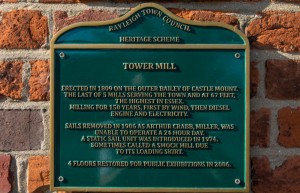
Image: chrisdorney/Shutterstock.com
That’s enough for us to be getting on with for the moment. Let’s talk the later history and the modern era.
Rayleigh in the Industrial Period
In 1746, the Rochford Hundred Adjoining Roads Division for the Essex Turnpike heavily featured the town and set up a trust. The King’s Highway was built, which led from Rayleigh to London Road and London Hill. This would have served as the main road until the A127 was built in the 1920s to replace it.
In the same century, Dutch workers moved into the town and built a little Dutch cottage for themselves which is still standing today and makes a regular tourist attraction to the town. They came from the coast, where they were helping to build the sea defences at Canvey. In those days we were constantly convinced the French were coming to attack us in our sleep. The Dutch Cottage is known for being the oldest council house in England… and one of the smallest.
The Famous Windmill Is Built
In 1809 the windmill was built. As we mentioned above, it is one of the tallest in Essex at 68ft off the ground. It fell out of use in the end of the century and was later picked up by the National Trust. They managed to preserve it and turn it into a second town tourist attraction. In 1923 they added the castle’s remains to their tourist attraction array, sometimes using the space as an open air concert and festival venue while letting the wildlife move into the motte. Svein built this castle at the time of the Domesday Survey. That we still have some outline of it in the landscape is remarkable. That was almost a thousand years ago.
While other towns were turned upside down by the industrial revolution, Rayleigh managed to survive most of it unscathed. Asides from the addition of the mill and the subsequent fall into disuse, they escaped the fate of many English towns. Some lost their land to the chemical and alchemy craze where chemicals like bleach were created in the UK, and some lost their surrounding landscapes to excessive mining and smelting. Rayleigh escaped the worst of it by becoming a small market town where people came to trade butters, meats, and leathers. It might sound sleepy, but it is how it managed to preserve itself all those long years after its importance of the Saxon era faded.
Modern Era Rayleigh
Modern-day Rayleigh is a quaint and peaceful market town, but it wasn’t always that way. At the start of the 20th century, the First World War hit, before the council houses were added in the 30s and 40s to situate a few of the residents from London that had lost their homes to the Blitz. During both great wars, the town paid dearly in terms of the young men. The town may have been small, but its sacrifice was large. The memorial is a plaque that is situated in the Holy Trinity Church that you can see from the high street.
During WWII there were air-raid shelters on the playing fields at the Rayleigh Secondary School (Fitzwimarc School). A kilted Scottish regiment were situated in the school for a few weeks, bringing tanks to the area. There were munitions factories in the surrounding towns, attracting the odd stray London bomber. Apparently, 14 bombs were dropped on the Hockley Woods area and a few cows became collateral damage.
Since the wars, there has been significant improvement to the town centre… at least until the 70s, when the town council voted to protect the buildings from further change. The high street has evolved along the same lines as many other English high streets. It has gone from traditional family shops like butchers and bakeries to being filled with Costas and supermarkets. Still, you can find the odd specialist shop if you look hard enough
Modern era Rayleigh is a pretty place to this day, retaining the country charm that so many towns lost during the industrial era and post-war years.
Famous People from Rayleigh?
We wanted to know if there were any famous people to have come from Rayleigh and this is what we managed to dig up:
- Bernard Braine, a conservative party MP.
- Mark Francois, a conservative party MP.
- James Rodd, a politician in Australia.
- An Anglican religious writer from the 18th century called Arthur Ashley Sykes.
- And a priest named Peter Taylor.
So not doing great on the famous people stakes. Maybe we should just move on to the attractions.
Attractions in Rayleigh
This little Essex town is perfectly placed to be in-between loads of attractions. Here are some of our favourite places to visit if you are having a holiday in Rayleigh.
Historic Sights and Landmarks
The Rayleigh Windmill is one of the top listed attractions in town. It was operational all the way back in the 19th century and is now celebrated as a 210-year-old listed building. You can use it as a wedding venue, you can take the tour, and you can hire it for educational group tours. It’s a Grade II listed building and it has been lovingly restored.
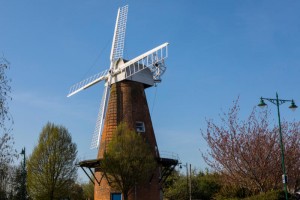
Image: hrisdorney/Shutterstock.com
The Dutch Cottage is part historic site, part landmark, and part mini architectural masterpiece. If you are looking for somewhere in town to take Instagram pictures, this is it. Many tourists come to visit this tiny little house, which was one of the first and the smallest, council houses in Britain. It’s one of the few places in the surrounding countryside that still has the thatch.
The Rayleigh Mount is another well-known attraction in town. Situated around the town centre, this area would have once held the castle. Now it is an occasional outdoor venue and a haven for local wildlife. This is a lovely area to explore, spend an afternoon, or take the dog for a walk. Take a tour and enjoy soaking up the wilderness in the middle of a town 30 miles from London.
Galleries and Museums
The Rayleigh Town Museum is another of the favourite attractions in town according to both locals and tourists. It will give you a more detailed overview of the town’s history than we ever could and is popular among both tourists and schools. It has amassed an impressive collection of town artefacts throughout the years and has some beautiful old pictures of the town throughout the ages.
Not quite a gallery but crafty, check out the Clay and Craft Cottage Pottery workshop in Rayleigh. This place lets you make and decorate your own pieces of pottery, which is a great thing to do with your friends on a weekend. Pottery is a calming hobby that many find interesting. Especially since you get to keep what you create at the end of it. You may have to come back after it’s been fired, though. Kids also love this because they get to play with paint, make something they can use, and explore their own sense of creativity.
Outdoor Attractions
Technically an indoor attraction, the MegaCentre Rayleigh is where you go for things to do with the kids. It got multiple levels of playing fun and an excellent soft play centre that lets parents get five minutes’ peace. They are available to hire for parties and have an onsite café for you to enjoy. The centre is a Christian Charity run operation so give freely.
Another indoor that should be an outdoor attraction, is the Base Jump Trampoline Park that is just outside of town. This is a games and entertainment venue that is out of this world good fun. Suitable for ages 5 and up, this trampoline park just lets the kids let loose. It’s a great party venue, a brilliant place to hang out with your mates, and it’s even fun for adults.
The Heritage Trail
No visit to Rayleigh or Essex for that matter is complete until you have walked the towns heritage train. There are 21 locations but the good news is that you can do it in a couple of hours. Apart from a few outliers, most are within a reach of the high street. There is a great site here that gives you a lot more detail.
Football
The town has a local team Rayleigh Town FC who play in the Essex Olympian football league. If you fancy taking in a game they play at the Sports & Social Club on London Road. They have both Boys & Girls junior teems too if you are planning to move here and have a football-mad young family. You can check out our team guide here.
Recreation
Rayleigh has an indoor go-karting arena that you can go play on. Use it for team building exercises or visit it with a bunch of your friends at the weekend. You don’t need to know how to drive, and you don’t need to be insured, but they might make you sign a waiver. If you are throwing a birthday party for your teen and you don’t know what to do, this might be the answer.
If you fancy a quick 18 holes then Rayleigh Golf Club is the place to be. It has a challenging beautifully landscaped course as well as a floodlit driving range. The town is also home to the Million Dollar Masters Club which adds a touch of extra excitement to a round.
Shopping and Retail
Most of the shopping in town can be found in the town centre. You should make an extra special effort to stop at Dee-Lights, which is a lovely place to go for a spa treatment. HRM Beauty is also in town though, contending for women’s attention as the best salon.
Don’t forget that being situated so close to London means you are only ever a bus or train ride away from some of the best shopping in the country. You will be able to get the basics in Rayleigh, but there’s no need for endless shopping malls when you are as uniquely placed as them.
Other Notable Attractions
We couldn’t cover everything within reach of Rayleigh in one article, but we did try our best. Here are some of the top contenders that didn’t make it in, but that you should still try and see in Rayleigh:
- If you want a nightclub to party in, you head to JJ Whispers.
- Bubble Splat is the kiddie version of the clay workshops.
- You can visit the Holy Trinity Church and see a service, or you can pay a visit to the war memorial plaque.
- You can spend the day shopping in London.
There are loads of things to get up to in the surrounding Essex countryside and you’re not too far from the coast, either. A few miles travelling in any direction should lead you to the numerous port towns and beaches that line the English coast to the southeast.
How to get to Rayleigh?
We are almost through our list of things you need to know about Essex’s favourite sleepy market town, except how you get there… so here goes nothing.
By Road
Follow the A127 east out of London.
By Rail
Look for Rayleigh railway station on the Greater Anglia line.
By air
The nearest airport is London Southend Airport.
By Boat
Good luck with that one!
Other Places to Visit?
If you are still in the market for the place to go on a Great British holiday this season, head over to our travel guides and see what you can find. Britain is a more interesting holiday destination than you might think.
[ii] https://www.bbc.co.uk/history/ww2peopleswar/stories/12/a3289412.shtml

